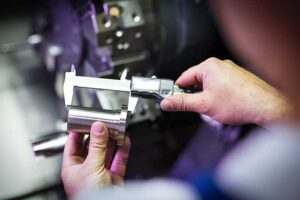
Design controls are a set of practices and procedures incorporated into the design process as part of current good manufacturing practice (cGMP) and in conjunction with a quality system as outlined by the FDA in 21 CFR Part 820. Design controls ensure that designs are regularly and systematically assessed as part of the development process to correct discrepancies between the design and its requirements. Design controls help to mitigate the risk to patients and medical device manufacturers by checking that the design meets the intended specifications. It is always easier and cheaper to correct design errors early in the development process than to fix them after the device has entered the market. With that framework in mind, this guide will review effective design control practices in the medical device industry.
Scope and device lifestyle
Manufacturers of Class II and Class III medical devices must establish and maintain design control procedures as outlined in the FDA regulations 21 CFR Part 820. Design controls begin once the design has exited its “proof of concept” phase and persist throughout the device’s entire lifetime in the market. Design controls also apply to new versions of existing devices on the market, no matter how minor the change might seem.
Quality aspects and management responsibilities
The medical device design and development phase establishes a product’s key quality aspects and regulatory requirements. Quality system requirements do not dictate the type of design process that a manufacturer must use. Manufacturers can use whatever method suits them best if they appropriately implement design controls.
Senior management is responsible for establishing a design plan that sets the device’s targets and constraints. They also decide how the design function will be managed and by whom. Senior management should also ensure that their organization has established internal policies for assessing new ideas, training design staff, using consultants, evaluating the design process, evaluating the product, and patenting and protecting the design. Additionally, management is responsible for allocating resources to carry out these processes.
Design controls overview
There are nine different aspects of design controls that the FDA requires: design and development planning, design inputs, design outputs, design reviews, design verification, design validation, design transfer, design changes, and a design history file.
- Design and development planning establishes a project plan and helps define a list of use cases for the device.
- Design input controls help define a complete list of user needs to ensure that the manufacturer has considered all design aspects.
- Design output controls translate the user requirements into a set of specifications for the device.
- Design reviews provide an independent assessment of the device by qualified experts and identify potential deficiencies in the design.
- Design verification confirms that the design outputs meet the design input requirements (i.e., the device meets its specifications).
- Design validation monitors the device in use and evaluates whether the device addresses the user needs outlined in the design inputs.
- Design transfer controls establish a procedure to transition a device from development to manufacturing smoothly.
- Design change controls ensure that manufacturers maintain a revision history for all documents and conduct an appropriate review and approval of design changes before implementation.
- A Design History File maintains a complete set of records for a device, including the documentation for the design controls mentioned above.
Design and development planning
For the design and development plan, 21 CFR Part 280 says, “Each manufacturer shall establish and maintain plans that describe or reference the design and development activities and define responsibility for implementation. The plans shall identify and describe the interfaces with different groups or activities that provide or result in input to the medical device design and development process. The plans shall be reviewed, updated, and approved as design and development evolves.”
Design and development planning ensures that the manufacturer controls the design process and meets quality objectives. Typically, design and development planning addresses the goals and objectives of the project, delineation of organizational responsibilities, identification of tasks and deliverables, scheduling, design review points, design review personnel and procedures, controls for design documentation, and notification activities. Planning allows management to control the design process, clearly communicate policies and goals, and measure conformance to quality system objectives. Design plans can apply to all design and development activities or specifically to an individual project.
Design input
21 CFR Part 280 outlines the requirements for design inputs: “Each manufacturer shall establish and maintain procedures to ensure that the design requirements relating to a device are appropriate and address the intended use of the device, including the needs of the user and patient. The procedures shall include a mechanism for addressing incomplete, ambiguous, or conflicting requirements. The design input requirements shall be documented and shall be reviewed and approved by designated individual(s). The approval, including the date and signature of the individual(s) approving the requirements, shall be documented.”
Design inputs are a device’s physical and performance requirements that are a basis for medical device design. Since design inputs are the starting point of product design, developing a solid foundation of requirements is the most critical design control activity. Developing a device using a comprehensive set of requirements results in significantly less redesigning and improved product quality. Developing a list of medical device requirements is complex and time-consuming, but thoroughness results in a superior end product.
The design input requirements result from the first stage of the design control process. After review and approval, the design input becomes a controlled document subject to change control procedures. Often, it is necessary to update the design inputs as you discover new information during the design process and problems are more fully understood.
Design output
21 CFR Part 280 instructs that for design outputs, “Each manufacturer shall establish and maintain procedures for defining and documenting design output in terms that allow an adequate evaluation of conformance to design input requirements. Design output procedures shall contain or make reference to acceptance criteria and shall ensure that those design outputs that are essential for the proper functioning of the device are identified. Design output shall be documented, reviewed, and approved before release. The approval, including the date and signature of the individual(s) approving the output, shall be documented.”
Design output means the results of a design effort at each phase and the end of the total design effort. You can think of design outputs as a set of specifications that satisfy the design inputs. The finished design output is the basis for the device master record. The total design output comprises the device, its packaging and labeling, and the device master record (DMR). Design outputs often become design inputs in subsequent stages.
Design outputs generally encompass work products, deliverables, design tasks, and specifications. Product specifications include drawings and documents such as assembly drawings, material specifications, process specifications, machine code, work instructions, installation procedures, and packaging specifications. Manufacturers must ensure that the design output characterizes all design aspects and allows adequate verification and validation. The manufacturer can achieve this by specifying the form and content of design outputs or by reviewing them retroactively as part of the verification process.
Design Review
As stated in 21 CFR Part 820, the requirements for design review are as follows: “Each manufacturer shall establish and maintain procedures to ensure that formal documented reviews of the design results are planned and conducted at appropriate stages of the device’s design development. The procedures shall ensure that participants at each design review include representatives of all functions concerned with the design stage being reviewed and an individual(s) who does not have direct responsibility for the design stage being reviewed, as well as any specialists needed. The results of a design review, including identification of the design, the date, and the individual(s) performing the review, shall be documented in the design history file (the DHF).”
Design reviews intend to assess design results, provide feedback to designers on problems, assess progress, and confirm that the project is ready to move on to the next stage. You can conduct design reviews with an internal or external focus. Engineers or manufacturers usually conduct internal design reviews, while an external design review involves the end user, whether a patient or a surgeon.
Design reviews differ from verification activities because design reviews are comprehensive and multidisciplinary reviews of the entire device. In contrast, verification activities may focus on specific design inputs and outputs. There is no particular requirement for the number of design reviews conducted, but frequent reviews can help detect and solve problems early in development. However, the manufacturer must establish a reasonable rationale for the number and type of reviews.
Another design review requirement is to include technically competent and independent reviewers. Depending on their review, these reviewers could consist of engineers, surgeons, material scientists, or nurses. It is up to management to ensure that the design review team is composed of experts with enough technical expertise to evaluate potential problems with the device. Design reviews must also include one independent reviewer, which means someone who does not have direct responsibility for the design under review. The independent reviewer does not have to be from another company, merely someone not involved in creating the design under review. This requirement intends to introduce a fresh perspective to the review.
In summary, design reviews evaluate the design in its current state, resolve concerns, and implement corrective actions to fix problems if necessary. These corrective actions usually include design changes or requirement changes.
Design verification
Design verification is outlined in 21 CFR Part 820: “Each manufacturer shall establish and maintain procedures for verifying the device design. Design verification shall confirm that the design output meets the design input requirements. The results of the design verification, including identification of the design, method(s), the date, and the individual(s) performing the verification, shall be documented in the Design History File.”
Design review, verification, and validation often overlap each other, so it can be difficult to tell them apart from each other. Verification is the process of ensuring that design outputs match design inputs, while validation is the process of ensuring that the device meets user needs. In general, they repeat in a cycle of verification, review, validation, review, repeat. Verification activities usually become more common and comprehensive as the design effort progresses.
A manufacturer may conduct many different types of activities to verify device functionality. The manufacturer should select and apply the techniques that work best for their specific application. Some examples of possible verification activities include the worst-case analysis of an assembly, thermal analysis, failure mode and effects analysis (FMEA), design traceability matrix, package integrity tests, or biocompatibility tests. All verification activities must be documented in the design history file.
Design validation
The FDA states that for design validation, “Each manufacturer shall establish and maintain procedures for validating the device design. Design validation shall be performed under defined operating conditions on initial production units, lots, or batches, or their equivalents. Design validation shall ensure that devices conform to defined user needs and intended uses and shall include testing of production units under actual or simulated use conditions. Design validation shall include software validation and risk analysis, where appropriate. The results of the design validation, including identification of the design, method(s), the date, and the individual(s) performing the validation, shall be documented in the Design History File.”
While verification is a narrow examination of design aspects, validation is a cumulative summation of efforts to ensure that a device conforms to user needs. It is not always possible to begin validation until a device has finished development; however, it is helpful to establish a plan for validating user needs early in the design process. Validation can introduce previously overlooked user needs, which may restart the iterative design process. Validation should look at all device aspects and use cases, including packaging, labeling, environmental conditions, and shipping. It should also consider all people who may interact with a device, including customers, users, and patients. Validation is an ongoing process that should occur even after the device has entered the market.
Design transfer
The requirements for design transfer are stated simply as: “Each manufacturer shall establish and maintain procedures to ensure that the device design is correctly translated into production specifications.”
The process of encapsulating knowledge of the device into production specifications is critical for ensuring device quality. Production specifications must ensure that a company produces a reliable device either in-house or through a contract manufacturer. Often, there is a disconnect between the engineering teams that design medical devices and the manufacturing teams that make them. Good design transfer processes ensure a smooth transition between design and production. Production specifications usually include written documents, engineering drawings, or inspection specifications, but they can also include training materials or manufacturing jigs.
Engineering feasibility and production feasibility can often differ because the equipment, tools, procedures, and personnel are different. A suitable design transfer procedure should include a qualitative assessment of the production specifications for completeness and adequacy; they should ensure that all documents that constitute the product specifications have been reviewed and approved and that the manufacturer uses only approved specifications.
Design changes
21 CFR Part 820 outlines design change requirements: “Each manufacturer shall establish and maintain procedures for the identification, documentation, validation or where appropriate verification, review, and approval of design changes before their implementation.”
The two primary elements in controlling design changes are document control and change control. Document control involves enumerating design documents and tracking their status and revision history. Change control is the enumeration of corrective actions determined during the verification and review of the design before design transfer. The main objectives of tracking design changes are to ensure that manufacturers track corrective actions to completion, design changes do not create new unresolved problems, and design documentation accurately reflects the revised design.
A document control system should identify documents in a logical order and link documents to the product or component. Control systems should have a master list of documents for a project. There should be an approval process to enter or modify a document that has entered the document control system, and the system should track revision history. Manufacturers should conduct periodic inventories of the control system to ensure that all contents are current. They should also assign at least one person to manage the design change system.
Change control systems should also incorporate a set of standardized procedures. For example, change requests originate from someone who identifies a design problem they believe should be corrected. If the change is reviewed and accepted, a change order could be issued to implement the change. The change order could be as simple as fixing a typo or as detailed as replacing entire systems. Design change procedures should always include re-verification and re-validation.
Design history file (DHF)
The final requirement for design controls outlined in 21 CFR Part 820 is for the Design History File. It states, “Each manufacturer shall establish and maintain a DHF for each type of device. The DHF shall contain or reference the records necessary to demonstrate that the design was developed in accordance with the approved design plan and the requirements of this part.”
The primary purpose of the design history file is to contain all the device records for submission to the FDA. The design history file should contain all necessary documentation to demonstrate that the manufacturer designed the device with the proper design controls and the approved design plan. Most aspects of the design controls outlined above require written documentation stored in the design history file. The FDA does not require the manufacturer to maintain the design history file in a single location. However, this is often good practice, as the FDA expects the manufacturer to have timely access to the information when required.
In conclusion, design controls play a vital role in ensuring that medical devices meet regulatory requirements and user needs while maintaining high standards of safety and effectiveness. By incorporating structured processes like design verification, validation, and review, manufacturers can detect and address potential issues early in development, minimizing costly redesigns or post-market failures. Each phase of design control, from planning to maintaining a comprehensive Design History File, is essential in delivering reliable, compliant devices that protect patient well-being. Ultimately, effective design control practices support regulatory compliance and foster innovation and quality in medical device development.
Need Help Navigating the FDA?
About Synectic Product Development: Synectic Product Development is an ISO 13485 certified, full-scale product development company. Vertically integrated within the Mack Group, our capabilities allow us to take your design from concept to production. With over 40 years of experience in design, development, and manufacturing, we strive for ingenuity, cost-effectiveness, and aesthetics in our designs. Learn more about our medical device design services and see how we can help your next project.


